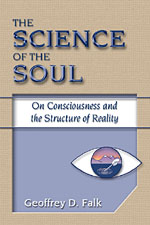 The Science of the Soul
The Science of the Soul The Science of the Soul
The Science of the SoulNumerous books have been published over the past few decades on the subject of the apparent similarities between Eastern philosophy and the ideas of the "New Physics." However, without exception, these writings have failed to address the real meaning of "As above, so below": that the macrocosm of the universe is mirrored in the microcosm of the human body, and that the archetypal patterns of structure on the causal and astral levels of reality have their lower reflections on the physical level of being.
In The Science of the Soul, Geoffrey D. Falk corrects this significant oversight. Drawing equally from yogic, Buddhist, Christian and Taoist sources, Falk shows that it is only by considering the detailed structure of the cosmos and the microcosmos that we can understand both the unified message which the scriptures have tried to convey, and their precise relation to the physicists' understanding of the physical level of reality - in particular, the ideas of David Bohm and Itzhak Bentov.
|
Endorsements |
I endorse whole-heartedly the road you have traveled. Light is a - perhaps the - powerful entry point to Spirit, and you ring the changes on it well. It's a book I would like to have on my shelves to refer to. Huston Smith, Ph.D., author, The World's Religions
Combines ... astutely some of the great wisdoms of the spiritual world with the emerging understanding of the physical universe. Dr. James Fadiman, Board of Editors, The Journal of Transpersonal Psychology
As a heroic journey of the mind into the mysterious realm of consciousness and maya in a vehicle fitted with the wheels of modern science and powered by the engine of yoga, the book merits a close study. S. Srinivasachar, The Ramakrishna Institute
|
Table of Contents |
Introduction
I. As Above, So Below
II. The Consciousness of Light
III. The Essence of Creation
IV. On Good and Evil
V. Freedom of Choice
VI. On the Nature of Om
VII. Holograms
VIII. Psychology and Motivations
IX. Symbolism and Structure in Mythology
X. Chaos, Light and Manifestation
XI. Wholeness and Fragmentation - I
XII. Wholeness and Fragmentation - II
XIII. Psychology and Transcendence
XIV. Summary
XV. Conclusions
Bibliography
Permissions
Index
|
Excerpt |
INTRODUCTION
It is well known to all who have undertaken a thorough investigation of the quantitative ideology underlying the practice of meditation as a means toward the attainment of expanded states of consciousness, that consciousness is the fundamental reality at the basis of all creation. The fact that the only difference between matter, energy and dualistic consciousness is in their respective rates of vibration has also been much emphasized.
Given, then, this nature of matter as a low rate of intelligent vibration or consciousness, and given also the validity of "As above, so below," we must find the behavior of consciousness reflected in the conduct of physical matter; the former qualities being ascertainable through meditation-born intuition or mystic insight, while the latter are measurable in the physicists' laboratories. However, the quantitative relations between the behavior of the physical world and the characteristics of its constituent consciousness have rarely been elucidated. What I have attempted to provide in this book is a non-reductionistic model of the behavior of consciousness as the basic stuff of the cosmos, to explain as many aspects as possible of the expanded or mystical states of awareness; as well as a concomitant demonstration that the principles upon which the operation of the physical world is based occur as a necessary consequence of the characteristics of the inner realms of consciousness.
Such a non-reductionistic model will, therefore, not attempt to explain mystical experiences in terms of Pribram's holographic model of the brain's storage of memory, for example. It might, however, embody a higher universal or archetypal structure, of which physical holograms are merely a lower reflection on the plane of matter.
Further, since all individualized finite consciousness is only a subset of the Infinite Ocean of Consciousness which has become all waves of matter, any valid explanation of the basic nature and behavior of mind and consciousness (such behavior being essentially the domain of psychology) must include within its scope the root of all physics and philosophy. Physics, for all particles are simply waves of certain rates of vibration of the Ocean of Consciousness; and philosophy, since freedom of choice, the fundamental question of philosophy, is a function of consciousness, not of anything at a reductionistic atomic or molecular level (e.g., the Heisenberg Uncertainty Principle):
Quantum physics has nothing to do with the free will problem. If there is such a problem, it is not furthered a whit by the latest development in physics.
-Erwin Schrodinger
Thus, the model we are seeking will necessarily bridge the disciplines of psychology, physics and philosophy. This cannot be avoided, nor should it be: once we acknowledge that consciousness is the basic stuff that has become all mind and matter--this, however, not at all implying a naive idealism in which "I create reality through my perception of it"--we cannot inexorably compartmentalize psychology, philosophy and physics as separate from one another. As with any symbolic model, however, it is crucial that one remember that the map-model is not the territory of reality, but is merely a mental representation of that territory: it is the "menu," not the "meal." The "territory" of reality-in-itself can be known only through the direct experience of consciousness by consciousness in intuition, not through any sensory experiences or concepts of the intellect.
Blue Dolphin Publishing, 2004